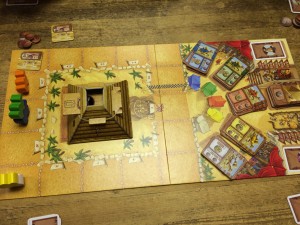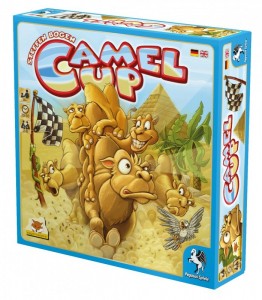Review: Camel Up
Posted by James (admin) on May 20th, 2014
 Camel Up is a simple game so it is surprising how much interaction there is and how lively it can be. During the game, camels move around a simple circuit; however, players do not own a specific camel as you may expect. Instead, players take actions which can move the camels as well as try to predict which camel will win the current round, as well as the overall race. The winner is the player with the most money (Egyptian Pounds, or EPs) at the end of the game.
Camel Up is a simple game so it is surprising how much interaction there is and how lively it can be. During the game, camels move around a simple circuit; however, players do not own a specific camel as you may expect. Instead, players take actions which can move the camels as well as try to predict which camel will win the current round, as well as the overall race. The winner is the player with the most money (Egyptian Pounds, or EPs) at the end of the game.
Players take turns by performing one of 4 actions which are:
1. Move a camel
The player drops 1 dice out of the pyramid and moves the matching coloured camel that number of spaces forwards along the track. (There are 5 dice – one for each camel each with values 1 to 3 – more about the pyramid later.) If camels are moved to space occupied by camels they are stacked on top of those already there. When camels move, they carry any other camels already on top of them along with them too. This action earns the player 1 EP. (The dice only get placed back in the pyramid after all 5 have come out which and this ends the round.)
2. Place/Move their desert tile on the race track
This tile earns 1 EP for its owner each time a camel lands on it, plus it moves that camel forwards 1 space if the tile is oasis side-up, or backwards 1 space if the tile is mirage side-up.
3. Take a betting tile
There are 3 camel betting tiles for each coloured camel. When a round ends, players earn/lose EPs based on the current race position of the camel that matches each tile. Players gain 5, 3 or 2 EPs (depending upon the tile) if the matching camel is leading, gain 1 EP if the matching camel is second, and lose 1 EP if the matching camel is not currently first or second. (Ties between camels in a stack are broken by being higher up the stack.)
4. Predict the overall winner or loser
Each player has 1 card for each coloured camel. As an action, they can place a card (face-down so other players don’t know what was predicted) on either the winner prediction, or loser prediction, piles. At the end of the race, players that correctly predicted the winner/loser earn EPs – the first correct prediction gains 8 EPs, then 5 EPs and so on, but all incorrect predictions lose the player 1 EP.
When the last dice is removed from the pyramid, the round ends and players work out how much cash they have earned (or lost); then, apart from the camel positions, everything else is reset and the next round begins. As soon as any camel crosses the finish line, the game ends and the cards predicting the winner and loser are revealed and scored.
THOUGHTS
Camel Up is very simple and the players have little control over where the camels will move to apart from placing a desert tile which might increase or decrease some movements. However, whilst the camels’ movements are determined by dice (so down to luck), the game is really about your decisions and making better ones than your opponents by choosing (a) when to take risks (i.e. take a betting tile or make a prediction) before others do which is usually when there is less information, and (b) when to reveal information by moving a camel which earns a little cash but at the expense that the information helps other players before your next action.
There can even be a fun element of denial to the game too. For example, you may want to take a betting tile even though it is likely to cost you 1 EP because you don’t want another player to have the small chance of gaining the 5/3/2 EPs themselves. Also, a player may end a round by using the fifth camel move action and gain 1 EP even when they could gain more EPs from a different action just so other players can not earn further EPs that round.
There aren’t many actions but they feel different but well-balanced: Moving a camel is safe but only earns 1 EP and gives opponents information. Placing the desert tile gives no guaranteed income but can earn multiple EPs (and can influence where camels go which can be useful if you have some betting tiles or made predictions). The betting tiles can earn you cash but can also lose it too – plus, the tiles that earn 5 EPs usually require taking them early when less information is available. Predicting the winner/loser can earn lots of EPs but you’re usually never quite sure how many because you don’t know if predictions before yours are corrector not.

Stacking up the camels on a space is a clever idea – Not only do the camel pieces physically stack on top of one another (which looks cool), but this also means the race order can change a lot in unexpected ways. A camel may look buried in a stack but often they break free because of the order in which the camels move. The dice just have values 1 – 3 on them so it’s easy to work out the relative odds of a specific event happening; however, it’s the combination and order of what happens which is more difficult to work out – and is usually the cause of much humour. In one game I played, one player took the highest value betting tile for 3 different camels during a single round because the ‘likely round winner’ kept changing!
The game is very dynamic as the situation changes after every player’s action – One camel move can change the race positions making betting tiles and predictions more/less appealing than during the previous player’s turn, or taking a betting tile can change your thoughts on what action to take. As a result, each player’s decision is slightly different than the previous, or next, player. Also, turns are very, very short (so there is almost no downtime).
The components are very good (as you’d expect with Eggertspiele and Pegasus Spiele) but the card pyramid should be highlighted specifically. To reveal a dice, the player turns it point downwards, and presses the slider which opens to drop out one dice (and then springs back due to an elastic band). The same game mechanic could have been served using a bag to draw a dice and then rolling it; however, the pyramid drops out an already rolled dice which is quicker and feels more definitive, plus the pyramid adds great visual appeal to the game and a signature component too.
I think the gameplay may be fairly similar after a lot of replay – the camel positions and situations will vary every game; however, the gameplay and choices are the same each time. I think this will be acceptable as it’s a light game and it’s more about making better choices than your opponents.
The game can be played with 2 to 8 players and I am very intrigued to see how it will play with the full 8. I think it will still be fun – there will be a lot more competition to take betting tiles leading to wilder speculation; however, players will take fewer actions each round which may feel a little less engaging. Still, a game that plays with 8 – especially a light filler where turns are very short – is a welcome idea.
Overall, I really enjoyed Camel Up – there is an air of excitement as each camel dice is revealed and the outcome of players’ risks becomes more clear. In my games, there was lots of interaction between players as they tried to convince each other into taking outrageous risks, or made fun of earlier decisions they had made. I think it will serve as a great filler for gamers (my group consisted of entirely serious gamers and we had a lot of fun) as well as being a game for families and lighter gamers alike. I can see why it has been nominated for the Spiel des Jahres (and reminds a bit, in spirit, of previous SdJ nominee Augustus which was also simple and fun too).
James.
[Played with 4 players]


June 1st, 2014 at 1:40 am
There aren’t many reviews of this game out there so I appreciate you taking the time to do your own. I gotta try this one! (which means I have to order it).
June 1st, 2014 at 1:48 pm
Thanks, Jacob. It’s a fun game. I think I know 3 people who bought it after one play because it was infectiously entertaining. Let me know what you think of it when you get to play it.